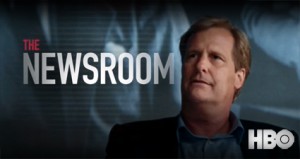I finally got a chance to see HBO’s The Newsroom. As is the case I’m sure with doctors and police officers who watch programs about their lines of work, I found much of the program laughable. 
But we’re grown ups here, so there has to be some recognition that the goal of this program isn’t to document, but to entertain. And, I did find it entertaining.
Frankly, I am amazed the television newsroom has avoided the spotlight of dramatic television for as long as it has. The possibilities for plot lines involving personality conflicts, substance abuse, sex and the bizarre wrapped in a breaking news narrative are endless.
With The Newsroom though, the cliches were endless – and the unlikely HR and operational plot features were good for several chuckles.
One of the funniest elements was the staff’s fixation about what color (red, yellow – like the terror alert system) news stories were assigned by the wire service as they appeared in their newsroom computer system. This idea of news judgement being subjugated to any third parties assignment of a color code really cracked me up. Frankly, if it were possible to substitute color coding for actual news judgement, curiosity, intuition and experience, the world’s media moguls would be overjoyed – because it would allow them to automate more jobs out of the newsroom – which of course is their not-so-secret dream.
A no-questions-asked color coding system would also allow the possibility of new revenue streams since “red” color coding could then be sold. Have a press release? Well, for $10,000 – it will be dropped right into the rundown across the ownership group’s properties as a high priority “red” news story. Can only afford “yellow?” Well, the computerized producer will pop that one into the second segment. This may sound ridiculous, but it’s closer to reality than you might think. But I digress.
In the end, the color coded news alert meme actually feeds into the program’s fatal flaw: the idea that news occurs in the newsroom. I know I didn’t invent the saying, “Despite the name, news doesn’t happen in the newsroom,” but I used it frequently during my time in local television news. To me, it remains one of the great truths in journalism – and in public relations too – where the importance of “story” is still underestimated.
The Newsroom and The West Wing both very clearly share the same DNA – that belonging to uber-producer Arron Sorkin who created both shows. Sorkin seems married to a flawed idea: that a lot of quick whited and highly intelectual dialog among true believers in a cloistered echo chamber, be it a government office or a newsroom, can solve the world’s problems, or find truth, no matter how separated from real-world events on the ground. This is one of the great fallacies of government and journalism.
As a national network with significant resources, my thesis is that the real work at The Newsroom shouldn’t be portrayed as happening primarily in the newsroom at all. But of course that would make producing The Newsroom prohibitively expensive to make. Which is the same reason original news gathering is so out of fashion.
So as a practical matter, it’s cheaper to perpetuate the idea that most of the news is gathered on the phone back at HQ – even if news doesn’t happen in the newsroom.









